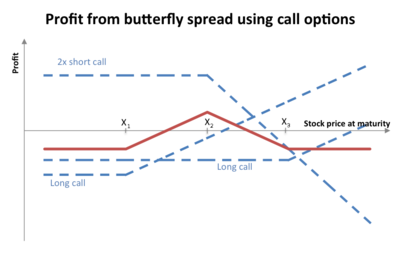|
Butterfly (options)  In finance, a butterfly (or simply fly) is a limited risk, non-directional options strategy that is designed to have a high probability of earning a limited profit when the future volatility of the underlying asset is expected to be lower (when long the butterfly) or less lower (when short the butterfly) than that asset's current implied volatility. Long butterflyA long butterfly position will make profit if the future volatility is lower than the implied volatility. A long butterfly options strategy consists of the following options:
where X = the spot price (i.e. current market price of underlying) and a > 0. Using put–call parity a long butterfly can also be created as follows:
where X = the spot price and a > 0. All the options have the same expiration date. At expiration the value (but not the profit) of the butterfly will be:
The maximum value occurs at X (see diagram). Short butterflyA short butterfly position will make profit if the future volatility is higher than the implied volatility. A short butterfly options strategy consists of the same options as a long butterfly. However now the middle strike option position is a long position and the upper and lower strike option positions are short. Margin requirementsIn the United States, margin requirements for all options positions, including a butterfly, are governed by what is known as Regulation T. However brokers are permitted to apply more stringent margin requirements than the regulations. Use in calculating implied distributionsThe price of a butterfly centered around some strike price can be used to estimate the implied probability of the underlying being at that strike price at expiry. This means the set of market prices for butterflies centered around different strike prices can be used to infer the market's belief about the probability distribution for the underlying price at expiry. This implied distribution may be different from the lognormal distribution assumed in the popular Black-Scholes model, and studying it can reveal ways in which real-world assets differ from the idealized assets described by Black-Scholes.[1] Butterfly variations
References
|
Portal di Ensiklopedia Dunia